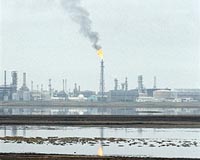 |
West Lafayette IN (SPX) Dec 23, 2009 Refineries could trim millions of dollars in energy costs annually by using a new method developed at Purdue University to rearrange the distillation sequence needed to separate crude petroleum into products. The researchers have demonstrated their method on petroleum plants that separate crude, showing that 70 of the new sequences they identified could enable oil refineries to improve the energy efficiency of this step anywhere from 6 percent to 48 percent, said Rakesh Agrawal, the Winthrop E. Stone Distinguished Professor of Chemical Engineering. "This is important because improving efficiency by 10 percent at a refinery processing 250,000 barrels per day would save in excess of $12 million a year if oil were priced at $70 a barrel," said Agrawal, who is working with doctoral student Vishesh Shah. "And that's just a single refinery. For the U.S. petroleum industry as a whole, this is a huge potential savings." Research findings appeared online this month in the AIChE Journal, the official peer-reviewed journal of the American Institute of Chemical Engineers, and will be included in a future issue of the magazine. Chemical plants spend from 50 percent to 70 percent of their energy in "separations," which are usually distillation steps required to separate a raw material into various products. In the case of petroleum, four distillation columns are needed to separate raw crude into five separate components - naphtha, kerosene, diesel fuel, gas oil and heavy residue. Some of these components are later used to make gasoline. "Separations are a huge part of what chemical plants do," Agrawal said. "Improving efficiency by only a few percentage points translates into major savings. For every 100 barrels of oil distilled, nearly two barrels go into supplying energy for distillation. That's a lot of oil." Crude petroleum is fed into the system, heated and vaporized. Vapor rises up the first column, and the product is collected in a condenser at the top. The process is repeated in additional columns, with the number of columns depending on how many components are to be separated. But the distillation is more energy efficient depending on the order in which the columns are operated. "There are many ways to arrange the columns," Agrawal said. Shah created a computer algorithm that identifies all of the possible sequences and then determines which require the least heat and energy. The Purdue researchers used their new technique to determine there are nearly 6,000 possible sequences for the four columns used in petroleum distillation. "Once we know all of the possible ways they can be arranged, then we can tell you which ones have the potential to be the most energy efficient," Agrawal said. Petroleum refineries have been using the same sequence for about 75 years, and it is the most energy efficient of the sequences known to industry, the Purdue researchers confirmed using their new method. The researchers also determined, however, that 70 of the new sequences identified have potential to consume less energy than the sequence now used by industry. Those 70 sequences range from being 6 percent to 48 percent more energy efficient than the method currently in use. "However, just because a particular sequence would be more energy efficient doesn't mean it would be practical for industry to implement," Agrawal said. "There are a lot of challenges. Some are easy to build and just involve trivial retrofitting, and some are more difficult. So we'll need to work with companies and refinery experts to determine which sequences could be built." The U.S. Department of Energy's Industrial Technology Program funded the research. The journal paper was written by Shah and Agrawal. Previous, related work also involved Arun Giridhar, a Purdue postdoctoral researcher. As a supplement to the paper, the researchers also provided more than a gigabyte of data on all of the distillation sequences identified using the technique for the separation of mixtures containing up to eight components. Share This Article With Planet Earth
Related Links Purdue University Powering The World in the 21st Century at Energy-Daily.com
 Chinese-led group initials deal for Iraq oil field: ministry
Chinese-led group initials deal for Iraq oil field: ministryBaghdad (AFP) Dec 22, 2009 A consortium led by China's top oil producer initialled a deal with Iraq on Tuesday to develop the southern Halfaya oil field, oil ministry spokesman Assem Jihad told AFP. "Yes, they signed the contract today," he said of the group made up of China National Petroleum Corp. (CNPC) and which also includes France's Total and Malaysia's Petronas. The three companies are aiming to increase ... read more |
|
| The content herein, unless otherwise known to be public domain, are Copyright 1995-2009 - SpaceDaily. AFP and UPI Wire Stories are copyright Agence France-Presse and United Press International. ESA Portal Reports are copyright European Space Agency. All NASA sourced material is public domain. Additional copyrights may apply in whole or part to other bona fide parties. Advertising does not imply endorsement,agreement or approval of any opinions, statements or information provided by SpaceDaily on any Web page published or hosted by SpaceDaily. Privacy Statement |